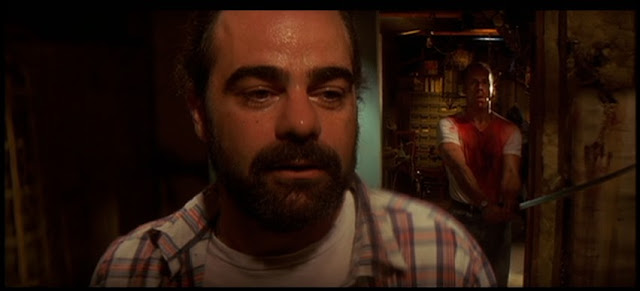The Dark Side Of The Moon album cover. [Image from the Wikipedia 'The Dark Side of the Moon' page; "Dark Side of the Moon",[a] licensed under fair use via Wikipedia.]
Individual songs from Pink Floyd's 1973 album The Dark Side Of The Moon, are synchronized by the band to play alongside certain scenes from Stanley Kubrick's 1968 movie, 2001: A Space Odyssey. These 'sync videos' are posted on YouTube, and are accessible by clicking on the links listed below.
2001: A Space Odyssey - Heywood Floyd's flight to the moon / The Dark Side Of The Moon - Money
 While the lunar lander spacecraft (above left) is on its way from a space station orbiting Earth (above right), to the moon, Heywood Floyd, who is aboard the lander, is shown sleeping (left) during part of the journey. Note the gold coloring of Floyd's surroundings inside the lander.
While the lunar lander spacecraft (above left) is on its way from a space station orbiting Earth (above right), to the moon, Heywood Floyd, who is aboard the lander, is shown sleeping (left) during part of the journey. Note the gold coloring of Floyd's surroundings inside the lander.
The lander also has an area within it that looks somewhat like a bank vault or gold bullion depository (below left). In the sync video, a 'cash register' sound plays when the stewardess in this vault/depository area, operates the food tray dispenser (below right). This sound, the presence of the vault area, and the gold color of the interior of the lander, taken together with Money's lyrics (e.g., "Grab that cash with both hands and make a stash"), suggest that Heywood Floyd's trip is tied in with something of monetary value, and with greed.

2001: A Space Odyssey - The foretelling of Poole's fate / The Dark Side Of The Moon - Us And Them
The demise of Discovery One astronaut Frank Poole is foretold in the part of the lyrics in Us And Them in which we hear a voice speaking, and one phrase spoken by this voice is, "So if you give 'em a quick short, sharp, shock": Mission computer HAL (whose camera 'eye' is shown in the screencap at left), is here thinking to himself that he is going to shock (that is, surprise) "'em", i.e., 'them' - Poole (below left) and his fellow astronaut, David Bowman (below right) - by performing some kind of drastic action directed against Poole.

2001: A Space Odyssey - HAL's attack on Poole / The Dark Side Of The Moon - Us And Them
The attack on astronaut Frank Poole by mission computer HAL, represents the fulfillment of that which was foretold in the other Us And Them sync video (from above), that is, the demise of Poole: HAL takes control of Poole's EVA pod (the small spacecraft shown at below left) while Poole's outside of it, about to perform a repair on the Discovery One spaceship, and HAL uses the pod to strike Poole so that Poole is sent off into space with a severed air hose (below right).

2001: A Space Odyssey - HAL disconnect / The Dark Side Of The Moon - Brain Damage and Eclipse
Astronaut David Bowman, wearing a green space helmet in the screencap at left, is here inside mission computer HAL's logic/memory compartment, disconnecting HAL's circuitry.
2001: A Space Odyssey - Stargate / The Dark Side Of The Moon - On The Run
Below left: In part of this sync video, the monolith (the shiny, black, rectangular object in the screencap) aligns with Jupiter and its moons. Below right: A portion of the stargate itself, as astronaut David Bowman sees it while moving through it.

2001: A Space Odyssey - Landscapes / The Dark Side Of The Moon - Any Colour You Like
The title of this song is a reference to the colorful views of Earth's sky and surface (below left and right, respectively) that astronaut David Bowman sees, after having passed through the stargate.

2001: A Space Odyssey - Ending sequence / The Dark Side Of The Moon - Time and The Great Gig In The Sky
As described in the caption to the two screencaps below, there is a match for part of the lyrics of Time, with the Space Odyssey 'hotel' sequence. During part of this sequence, astronaut David Bowman ages rapidly (in the sync video, while Time plays):

Bowman goes from a man around age sixty (above left) to a man of about seventy (above right), while part of the lyrics of Time that play are, "And then one day you find ten years have got behind you." (The screen time that elapses between the two shots shown above, is approximately two minutes).
Another vocal confirmation for this sync, comes in the (spoken) words of the second song in the sync video, The Great Gig In The Sky, a portion of these words being, "And I am not frightened of dying, any time will do, I don't mind. Why should I be frightened of dying? There's no reason for it, you've gotta go sometime." These words refer to David Bowman on his deathbed, which is what is being shown in the video while the words are being spoken, beginning at approximately the point shown in the screencap at left. Note that Bowman is gesturing with his right hand toward the rectangular, black monolith (click image to enlarge).
See the analysis of 2001: A Space Odyssey on this blog for a detailed explanation of the film's themes.
a. Cover for the album The Dark Side of the Moon by the artist Pink Floyd: by Hipgnosis and George Hardie. The cover art copyright is believed to belong to the label, Harvest / Capitol, or the graphic artist(s). Designed by Storm Thorgerson, drawn by George Hardie.
All song lyrics in this post are believed to be used in accordance with the U.S. Copyright Fair Use Act (Title 17, U.S. Code).
























